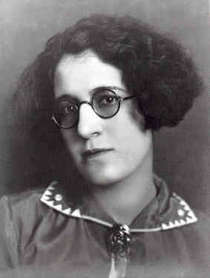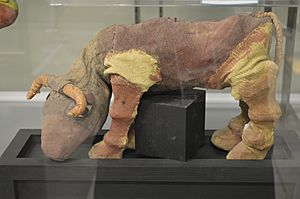Lola Cueto facts for kids
Quick facts for kids
Dolores "Lola" Velásquez Cueto
|
|
|---|---|
 |
|
| Born |
María Dolores Velázquez Rivas
March 2, 1897 Azcapotzalco, Mexico
|
| Died | January 24, 1978 (aged 80) Mexico City, Mexico
|
| Nationality | Mexican |
| Other names | María Dolores Velázquez Rivas de Cueto, Lola Velázquez Cueto |
| Education | Academy of San Carlos |
| Known for | painting, printmaking, puppet design |
| Spouse(s) | Germán Cueto |
| Children | 2, including Mireya Cueto |

María Dolores Velázquez Rivas, known to many as "Lola" Cueto, was a talented Mexican artist. She was born in Azcapotzalco, Mexico, on March 2, 1897, and passed away in Mexico City on January 24, 1978. Lola was famous for her paintings, prints, and especially for designing puppets.
She is most remembered for her work in children's theater. Lola created amazing sets and puppets for plays that helped kids learn. She took her last name, Cueto, from her husband, Germán Cueto. They had two daughters, and one of them, Mireya Cueto, also became a well-known puppeteer. Lola loved Mexican handcrafts and folk art. She often painted about them or made traditional items like tapestries, papel picado, and Mexican toys.
Lola Cueto's Life Story
Lola Cueto was born María Dolores Velázquez Rivas. Her parents were Juan Velázquez and Ana María Rivas. She was born in Azcapotzalco, which is now part of Mexico City.
When Lola was 12, she joined the Academy of San Carlos. This was a big deal because not many girls studied art there back then. She was one of the first female students! Lola was part of a group of students who wanted new ways of learning art. The Mexican Revolution stopped her studies for a while. Later, she went to another art school called Escuela de Pintura al Aire Libre.
In 1919, Lola married Germán Cueto, who was a sculptor. They were a well-known couple in Mexico City's art world. Many famous artists and thinkers were their friends, like Diego Rivera. This is when she started using her husband's last name, becoming known as Lola Cueto.
From 1927 to 1932, Lola and Germán lived in Paris, France. This time was very important for their art. In Paris, they first learned about puppetry and how to design puppets. When they came back to Mexico, they started a puppet theater called "Rin-Rin." The government helped them, and their puppet shows traveled to schools all over Mexico for 50 years! Lola and Germán separated in 1936. They had two daughters, Ana Maria and Mireya. Mireya, born in 1922, grew up to be a famous puppeteer and writer. She even won a special award for her life's work.
Lola Cueto passed away in Mexico City on January 24, 1978.
Lola Cueto's Career
Lola Cueto was one of the few women artists working in Mexico in the early 1900s. At that time, most artists were men. Other important women artists of her time included María Izquierdo. Mexico City was a busy place for art in the 1920s. Lola used her sewing machine to create modern tapestries. She mixed old Mexican styles with folk art, using a special embroidery machine.
Lola is best known for her work in theater, especially with puppets for children. Germán first thought of making puppets in Paris, but Lola really made it happen. Most of her theater work was about teaching. She started theater groups like Rin Run and El Colorín. These groups performed educational plays in cities and in the countryside. One of her most famous puppet shows was a ballet called “El Renacuajo Paseador.” It was shown at the Palacio de Bellas Artes in 1940.
When Lola lived in Paris starting in 1926, her tapestry work became very popular. French art magazines praised her as an important artist of the Mexican Renaissance. People in France and other Mexican artists knew her tapestries were special. They felt her art, made with a "timeless medium," reached more people than paintings or sculptures.
Besides puppets, Lola was very interested in Mexican handcrafts and folk art. This love influenced all her art. In the early 1920s, she designed and made tapestries. Her work was shown in Paris, Barcelona, and Rotterdam.
In 1932, a group called Troka was formed to teach different art forms to children. Lola was invited to join, and her puppetry work received funding. She even created an early abstract sculpture. The artist José Luis Cuevas said she was the first artist in Mexico to discover abstract art.
In the late 1930s, she joined the Sociedad Mexicana de Grabadores. She was very good at a printmaking technique called mezzotint, which creates beautiful light and shadow effects. She also made aquatint prints for a 1947 book about Mexican folk puppets.
Lola taught classes at Mexico City College. One of her students was the famous artist José Luis Cuevas. She also helped start the Liga de Escritores y Artistas Revolucionarios in her own home.
Unlike some other artists of her time, Lola didn't cause much fuss with her art. She used traditional styles and made fun of things like religious symbols through her puppets and paper mache figures. This was her way of commenting on faith in a changing Mexico.
Lola didn't have many art shows, but critics like Paul Westheim and artist Jean Charlot wrote a lot about her work. Charlot was very impressed by her embroidery. An exhibition of her work was held after she passed away at the Salón de la Plástica Mexicana. In 2009, there was a big show of her art, sponsored by the Instituto Nacional de Bellas Artes.
Lola Cueto's Art Style
Lola Cueto is best known for her work in children's theater, especially plays that helped kids learn to read. Her art also included weaving, watercolors, drawings, prints, oils, and gouache. She also designed puppets, theater sets, and traditional Mexican toys. People see her as a master and a creative leader in making puppets and children's theater.
Her early paintings were often Impressionist landscapes. Later, her art focused on Mexican handcrafts and folk art. She painted pictures of traditional Mexican toys because she was worried about too many factory-made toys appearing in Mexico.
Even though she wasn't just a craftsperson, Lola worked with many traditional crafts. These included lacquer, papel picado designs, embroidery, and making traditional toys and puppets for shows.
Some of her most famous creations are her machine-embroidered tapestries. These include a series inspired by the beautiful stained glass windows of old cathedrals in Chartres and Bourges. She also made tapestries with religious scenes and pictures of indigenous people.
See also
 In Spanish: Lola Cueto para niños
In Spanish: Lola Cueto para niños

